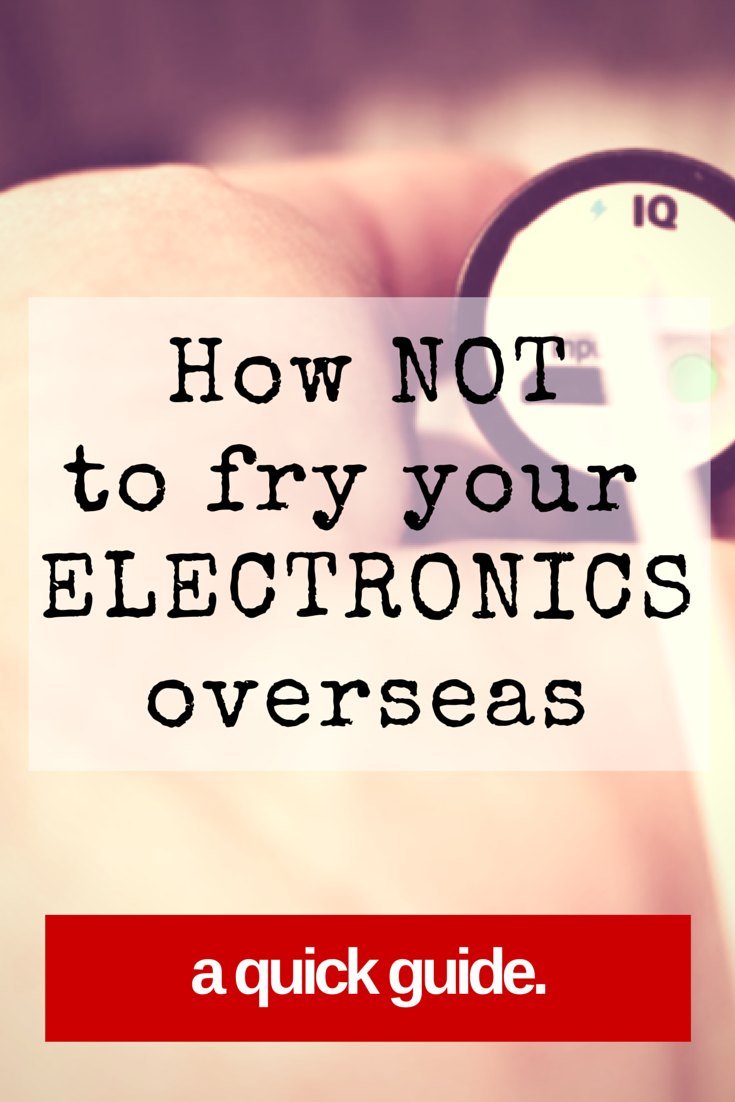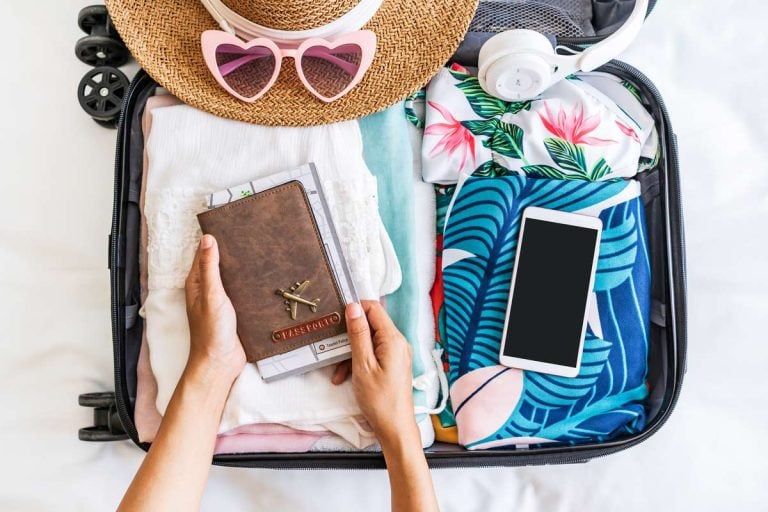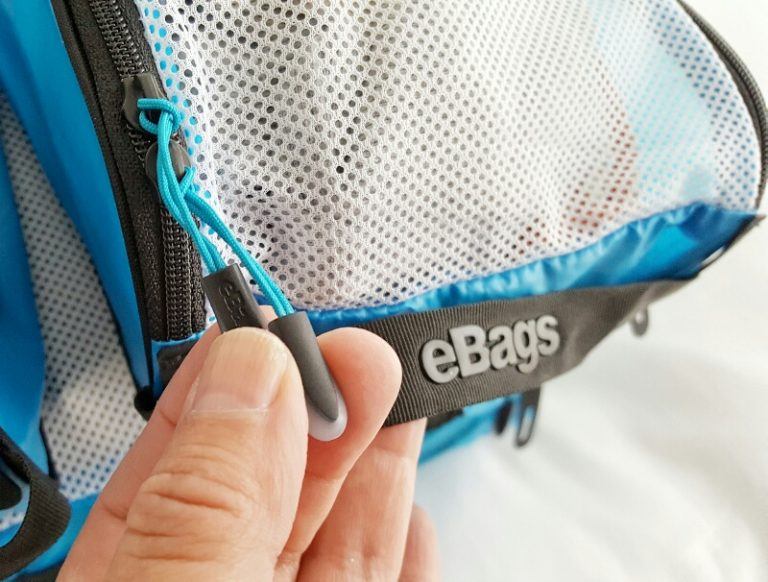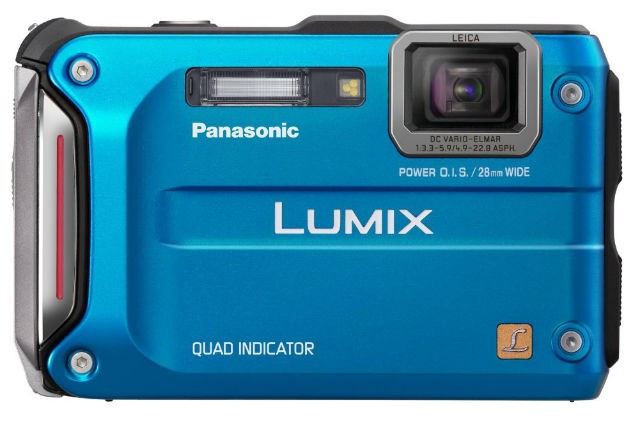How Not to Fry Your Electronics Overseas: A Quick Guide

Does anyone else find travel adapters and voltage converters confusing as hell?
Even after traveling the world for the last 10 years, I still need a quick brush up on how converters and adapters work whenever we travel somewhere new.
So, I thought I’d write a short, easy guide for all of us who just want to keep from frying our electronics overseas.

So here’s the important thing to know: the difference between a converter and an adapter.
A travel adapter connects your plug end to the outlet wherever you travel. An adapter does NOT change the power output coming from the outlet.
A voltage converter adjusts the power output from the outlet and converts it to the proper voltage.
So how do you know if you need a converter or an adapter?
If the voltage your smartphone charger or laptop (or any electrical appliance) uses is the same as the voltage at your destination, all you need is an travel adapter. Even if the shape of the outlet plug is very different, your electronics will be fine as long as the voltage is the same.
Here’s an example: you plug your electronics into a Universal World Wide Travel Charger Adapter Plug, and select the prongs to fit into the outlet. Easy peasy.

If the voltage is DIFFERENT, then you’ll need a voltage converter. These can be a pain in the butt. They’re usually heavy, awkward and cost a lot more. We’ve never traveled with one, opting instead to leave any electronics that aren’t multi-voltage or the proper voltage at home. Conversely, we do travel with multiple adapters all the time since they’re typically light and small.
In layman’s terms:
If the voltage is THE SAME as your electronics, then all you need is an adapter.
If the voltage is DIFFERENT than your electronics, then you’ll need a converter.
How do you find what voltage your electronics can use?
You can usually find the voltage information on the device itself, just look for the input number. On a laptop, there’ll be a sticker on the brick of your charging cord, and it’ll be on the backside of your smartphone or tablet charger (not on the device itself).
Most devices that are dual voltage (they accept 110-120V as well as 220-240V) are automatic however some devices like hair dryers and even older laptops actually use a switch so check your device carefully the first time before plugging it in to an adapter.
And this is important: just because the plug looks the same, it doesn’t mean the voltage is the same. You can have the exact same plug in an outlet across the world, but the voltage may be different. This is where your smartphone or laptop can get very crispy, very quickly.
If you need to use a converter, make sure it has enough power to run your electronics. Most electronic devices like laptops and chargers don’t take much energy, but things like hair dryers and kettles require more watts and therefore a bigger and heavier voltage converter. A good rule of thumb is if in doubt, don’t plug it in.
If you’re looking for more information, check out The Roaming Boomers Ultimate Electricity Guide for World Travelers.
A surge protector is a good idea, too
While it isn’t necessary, it’s a great idea to have a surge protector. We’ve been carrying an awesome little Belkin 3-Outlet Mini Travel Swivel Charger Surge Protector for years now. See it on Amazon here.

It’s lightweight, and great for charging multiple devices. It’s only rated for 110-120V but we’ve actually used it without problems (mostly by accident) in European countries many times in our travels.
So far, so good. Even though I turned my phone into an iTurd in Spain, we haven’t (knock on wood) fried any electronics yet.







Hi Micki,
YES, to answer your first question, lol. Always confuses the hell out of me. All are spot on tips. I just research the country beforehand to figure out the voltage situation as well as the plug situation, and plan accordingly. Other than that, I prepared to shock myself 5 to 10 times during any normal trip as I forget the voltage change and touch the end of plugged in chargers for my laptop, LOL.
Tweeting from Bali.
Ryan
nice post! I don’t like these bulky multi plug adapters…
Yea some are so big you can kill someone with it.
Great guide!
So far, having a dual voltage laptop has allowed me to avoid trouble, but thanks for the fair warning for everyone else!
Oh man I hope a lot of people get to see this. On the receiving end, it’s so hard on us hearing that travelers fry their often expensive electronics… sometimes it’s a matter of an adapter only, but in some cases more is needed like a “step-down” to convert the power from 220 to 110, but checking the box attached to the cord can often prevent that with some things like laptops, not all have them though. Many cell phones become bricks. Glad to see this posted, it’s going to save people a ton of money and time.
Double benefit of the surge protector is being able to charge more than one electronic when staying in a room with only a single (often very oddly placed) outlet.
While I do have dual voltage electronics, I think I should pick up a surge protector soon as well … great suggestions!
Your distinction between a converter and adapter is informative for readers. The tips on how to locate the voltage information are useful as well.
That’s a good tip about the voltage converter. Most people would not want to burn out their electronic products overseas.
Great infographic, and thank you for sharing! It is so important to note how to deal with electronics in other places, for it is not always as simple as you might think!
It’s incredible to see how much these things vary from country to country. I think a surge protector sounds like a fantastic idea.
This blog post shares useful information on electronics. People who are looking to buy converter, adapter and surge protector would find this information worth reading. Good job!
Can a “fried” water pic ( I forgot to use a step down before plugging it into the wall) be repaired or is it ruined?
Sorry Susan. It’s likely fried however if it’s an expensive model you might be able to get it repaired. It might also only be the transformer that needs to be swapped out but you would need to talk to a repair center to find out for sure.
Great tips about making sure that you have dual voltage adapters. I need to get a laptop charger for my trip overseas. I’ll have to make sure it carries 240 volts.
I like your lamp tips. I need to fix my old lamp. It surged.
Thank you for this post! I was bouncing around in circles on other sites trying to understand this stuff, but you laid it all out very clearly.
Now feeling much more confident about using electronics on my upcoming international trip!
My Samsung Crome’s AC adaptor says input 100-240v.. Des that mean it’s dual voltage? Where I’m flying from US is 220v..also for cell phones, I’ve never seen people carrying transformers for recharging and neither did I use last time for my iphone but now I’m a bit confused?
Yes, if your adaptor says 100-240v then you can use it around the world. The only thing you would then need is a travel adapter to match the pins to the country you’re visiting. They’re usually pretty cheap and can be found in most gift shops, at the airport and sometimes even at the front desk of a hotel (So ask if you forgot to bring yours.) You can also grab something like this adapter from Amazon. It also has USB inputs to help minimize your extra accessories.
This blog post provides helpful electronics information. This information is worthwhile reading for those who are wanting to purchase a converter, adapter, or surge protector. Well done!
Thanks. Very helpful.